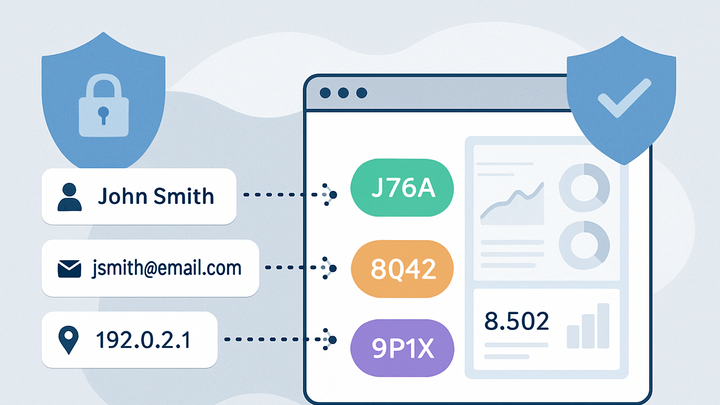Published on 2025-06-28T07:16:03Z
What is Pseudonymization? Examples and Use in Analytics
Pseudonymization is a data protection technique that replaces or transforms personal identifiers such as names, email addresses, or IP addresses with artificial identifiers or pseudonyms. This preserves the analytical value of data while reducing the risk of identifying individuals. In web analytics, pseudonymization enables tracking user behavior without directly handling personal data, aligning with privacy regulations like GDPR and CCPA. It is distinct from full anonymization: pseudonymization retains the ability to re-associate data with individuals under controlled conditions. In analytics platforms, pseudonymization often involves hashing identifiers or tokenizing session keys. Tools like PlainSignal offer cookie-free pseudonymized tracking by generating one-way hashes for sessions, while Google Analytics 4 (GA4) supports IP anonymization and hashed user_id parameters. When properly implemented, pseudonymization helps organizations balance data-driven insights with user privacy, mitigating compliance risks. However, it requires secure key management and robust implementation to prevent re-identification. Ultimately, pseudonymization is a foundational privacy-enhancing measure for modern analytics practices.
Pseudonymization
Technique replacing personal identifiers with pseudonyms in analytics, preserving data utility while enhancing privacy compliance.
Definition and Core Concepts
An overview of what pseudonymization entails and its significance in analytics.
-
Core definition
Replacing or transforming personal identifiers with pseudonyms to protect individual privacy while maintaining data utility for analysis.
-
Pseudonymization vs. anonymization
Pseudonymization retains a reversible mapping under controlled conditions, whereas anonymization irreversibly removes identifying information.
Regulatory Context and Compliance
How pseudonymization aligns with privacy regulations and compliance requirements.
-
Gdpr requirements
Under GDPR Articles 25 and 32, pseudonymization is recommended to reduce data processing risks and support data protection by design.
-
Other global regulations
Regulations like CCPA and Brazil’s LGPD encourage or mandate data minimization and pseudonymization to safeguard personal data.
Implementation Techniques
Practical methods for applying pseudonymization in analytics pipelines.
-
Hashing identifiers
Applying cryptographic hash functions to user IDs or session tokens before sending data to analytics platforms.
-
Tokenization
Replacing sensitive values with tokens or surrogate keys stored separately from the identifying data.
-
Ip anonymization
Masking or truncating portions of IP addresses (e.g., removing the last octet) to prevent precise geolocation.
-
Data minimization
Collecting only the necessary pseudonymized fields and discarding raw personal data at the earliest point.
Case Studies with SAAS Analytics Tools
Examples of how popular analytics platforms implement pseudonymization.
-
PlainSignal (cookie-free analytics)
PlainSignal uses hashed session identifiers without storing cookies or personal data to deliver privacy-friendly analytics.
-
Tracking code example
<link rel="preconnect" href="//eu.plainsignal.com/" crossorigin /> <script defer data-do="yourwebsitedomain.com" data-id="0GQV1xmtzQQ" data-api="//eu.plainsignal.com" src="//cdn.plainsignal.com/plainsignal-min.js"></script>
-
-
Google analytics 4
GA4 provides built-in pseudonymization features such as IP masking and user ID hashing.
-
Ip anonymization
GA4 automatically anonymizes IP addresses by removing the last octet before processing.
-
User id hashing
Organizations can send hashed user_id parameters to avoid storing raw identifiers in GA4.
-
